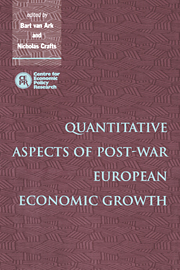Book contents
- Frontmatter
- Contents
- List of figures
- List of tables
- List of contributors
- Preface
- 1 Catch-up, convergence and the sources of post-war European growth: introduction and overview
- 2 Macroeconomic accounts for European countries
- 3 Sectoral growth accounting and structural change in post-war Europe
- 4 Measures of fixed capital stocks in the post-war period: a five-country study
- 5 Technology indicators and economic growth in the European area: some empirical evidence
- 6 Human capital and productivity in manufacturing during the twentieth century: Britain, Germany and the United States
- 7 Convergence and divergence in the European periphery: productivity in Eastern and Southern Europe in retrospect
- 8 Convergence: what the historical record shows
- 9 Growth and convergence in OECD countries: a closer look
- 10 On the historical continuity of the process of economic growth
- 11 Europe's Golden Age: an econometric investigation of changing trend rates of growth
- Index
10 - On the historical continuity of the process of economic growth
Published online by Cambridge University Press: 23 December 2009
- Frontmatter
- Contents
- List of figures
- List of tables
- List of contributors
- Preface
- 1 Catch-up, convergence and the sources of post-war European growth: introduction and overview
- 2 Macroeconomic accounts for European countries
- 3 Sectoral growth accounting and structural change in post-war Europe
- 4 Measures of fixed capital stocks in the post-war period: a five-country study
- 5 Technology indicators and economic growth in the European area: some empirical evidence
- 6 Human capital and productivity in manufacturing during the twentieth century: Britain, Germany and the United States
- 7 Convergence and divergence in the European periphery: productivity in Eastern and Southern Europe in retrospect
- 8 Convergence: what the historical record shows
- 9 Growth and convergence in OECD countries: a closer look
- 10 On the historical continuity of the process of economic growth
- 11 Europe's Golden Age: an econometric investigation of changing trend rates of growth
- Index
Summary
Introduction
From an empirical point of view economic growth is usually seen as a long-run process. Growth is conceived of as the trend in GDP over a substantial time span. Therefore, to explain growth by econometric techniques, one needs data for a large number of countries to apply cross-section analysis. The equation estimated contains the growth rate of GDP either in total or per capita as the dependent variable and a number of explanatory variables based on economic theory. There are basically two strategies that can be followed. First, the estimated equation may be derived from a theory of economic growth (e.g. Dowrick and Nguyen, 1989; Barro and Sala-i-Martin, 1992; Mankiw et al., 1992). Second, a pool of explanatory variables, which come from different macroeconomic theories, may be considered, assuming that they can be entered independently and linearly (e.g. Kormendi and Meguire, 1985; Grier and Tullock, 1989; Barro, 1991; Levine and Renelt, 1992). In the latter case it is useful to sort out variables that really matter. As shown by Levine and Renelt (1992), by applying cross-section analysis for the period 1960–89 to a sample of about 100 countries, the number of robust explanatory variables with respect to real per capita GDP is rather limited.
This chapter looks at economic growth as a process of the medium as well as the long run. In studying growth, one has to eliminate the business cycle, but there is no compelling reason to assume that differences in growth rates across sub-periods must be averaged out to get the right picture.
- Type
- Chapter
- Information
- Quantitative Aspects of Post-War European Economic Growth , pp. 388 - 414Publisher: Cambridge University PressPrint publication year: 1997
- 1
- Cited by



